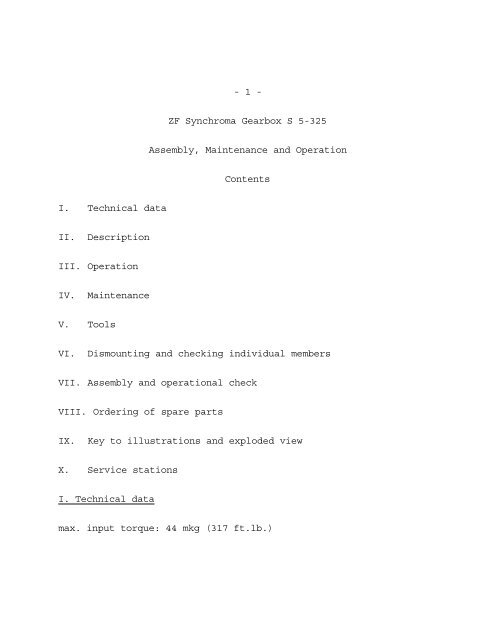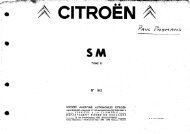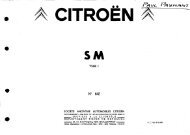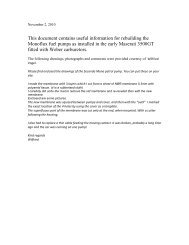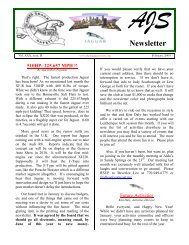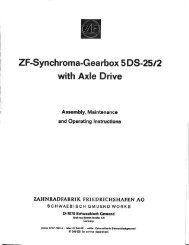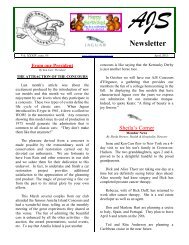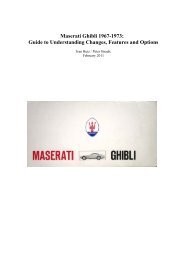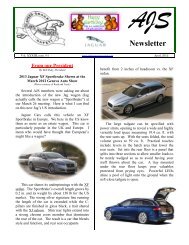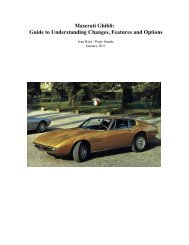ZF S5-325 service manual - The Car Nut
ZF S5-325 service manual - The Car Nut
ZF S5-325 service manual - The Car Nut
You also want an ePaper? Increase the reach of your titles
YUMPU automatically turns print PDFs into web optimized ePapers that Google loves.
- 1 -<br />
<strong>ZF</strong> Synchroma Gearbox S 5-<strong>325</strong><br />
Assembly, Maintenance and Operation<br />
Contents<br />
I. Technical data<br />
II.<br />
Description<br />
III. Operation<br />
IV.<br />
Maintenance<br />
V. Tools<br />
VI. Dismounting and checking individual members<br />
VII. Assembly and operational check<br />
VIII. Ordering of spare parts<br />
IX. Key to illustrations and exploded view<br />
X. Service stations<br />
I. Technical data<br />
max. input torque: 44 mkg (317 ft.lb.)
- 2 -<br />
Ratios: 1st speed 2.73<br />
2nd speed 1.76<br />
3rd speed 1.23<br />
4th speed 1.0<br />
5th speed 0.83<br />
reverse 3.31<br />
speedometer 1.75<br />
1st to 5th gear synchro mesh; reverse with sliding gear<br />
Weight of gearbox:<br />
approx. 56 kg (123 lb)<br />
Oil capacity:<br />
approx. 2.0 litres (3.5 pints)<br />
V. Tools<br />
Tool .1. Bench cradle Tool No.<br />
Tool .2. Bearing replacer for front taper roller bearing (307) on<br />
layshaft. Tool No. 1248 898 051<br />
Tool .3.<br />
Bearing replacer for rear taper roller bearing (304) on<br />
layshaft. Tool No. 1248 898 052
- 3 -<br />
Tool .4. Guide bush for synchronizer body (1st and 2nd gear).<br />
Tool No. 1211 898 001<br />
Tool .5. Replacer for roller bearing inner rings, bearing bush<br />
(436), sleeve carrier (438) and speedometer worm (442)<br />
on input shaft. Tool No. 1248 898 053<br />
Tool .6. 2 distance pieces for protecting the synchronizer rings<br />
during replacement of input shaft. Tool No. 1248 898 101<br />
Tool .7. Remover (main tool used in conjunction with tools .10.<br />
to .17. Tool No. 1248 898 201<br />
Tool .8. Input shaft remover. Tool No. 1248 898 204<br />
Tool .9.<br />
Yoke for removing clutch body from input shaft, when<br />
latter is pulled out of the housing with tool .8. Tool<br />
No. 1248 898 351<br />
Tool .10. Adaptor set for removing speedometer worm (442). Tool<br />
No. 1248 898 202<br />
Tool .11. Adaptor set for removing the sleeve carrier (438). Tool<br />
No. 1248 698 206
- 4 -<br />
Tool .12. Adaptor set for removing the needle bearing rings (436).<br />
Tool No, 1248 898 906<br />
Tool .13. Adaptor set for removing 1st speed gear (424) from main<br />
shaft. Tool No. 1248 898 207.<br />
Tool 14,. Thread protector for main shaft (414). Tool No. 1248 898<br />
054<br />
Tool .15. Adaptor set for removing the rear taper roller bearing<br />
(304) from the layshaft. (305). Tool No. 1248 898 209<br />
Tool .16. Adaptor set for removing the front taper roller bearing<br />
(307) from the layshaft. Tool No. 1248 896 208<br />
Tool .17. Adaptor set for removing the helical gear 5th speed<br />
(302) from the layshaft. Tool No, 1248 898 205<br />
Tool .18. Remover for reverse shaft (503). Tool No, 1248 898 206
- 5 -<br />
VI. Dismantling<br />
Fig. 1<br />
1. Removal of gearshift mechanism<br />
Place gearbox into bench cradle .1. and push selector forks into<br />
neutral.<br />
After unscrewing bolts (704) remove gearbox cover (707) from<br />
housing. (Fig. 1).<br />
Unscrew 2 swivel bolts (116) and remove 5th gear selector fork<br />
(634).<br />
Fi g. 2.<br />
2. Removal of main shaft and input shaft<br />
After loosening screw (809) remove speedometer drive. Engage two<br />
gears, remove tab washer (444) on output flange (443) and hexagon<br />
screw (445) and withdraw flange.<br />
Unscrew hexagon bolts (109 and 112) and nuts (105) of end housing<br />
(111). (Fig. 2). Remove one of the two set screws (107) so that<br />
the housing can be shifted slightly and then removed.
- 6 -<br />
Fig. 3.<br />
Release circlip (440) and remove speedometer worm (442) from<br />
output shaft, using tool .7. and adaptor set 9109 (Fig. 3).<br />
Release second circlip (440).<br />
Fig. 4.<br />
Remove distance bush (441) and release third circlip (440) on 5th<br />
speed gear. Using main tool .7. and adaptor set .11., withdraw<br />
complete 5th speed gear synchronizer body (406), placing remover<br />
on sleeve carrier (438) (Fig. 4). Remove main shaft key (416) and<br />
withdraw 5th speed gear (437) together with needle cage (413).<br />
Fig. 5.<br />
Withdraw bearing bush (436) from shaft, using main tool .7. and<br />
adaptor set .12. (Fig. 5) and remove, thrust washer (435).<br />
Fig. 6.<br />
Release circlip (301) and withdraw 5th speed layshaft gear(302),<br />
using main tool .7. and adaptor set .17. Loosen screws (110) and
- 7 -<br />
remove Intermediate plate (104). Unbend looking<br />
piece(429),<br />
engage two gears and unscrew look nut (430) with a<br />
commercial hook spanner. (Fig. 6). Remove look nut (201) on input<br />
shaft (205) in the same manner.<br />
Fig. 7.<br />
Put sliding sleeves into neutral and place tool .9. between<br />
housing wall and 4th speed clutch body (on input shaft). Withdraw<br />
Input shaft with the aid of tool .8. (Fig. 7). Press<br />
bell bearing (202) and roller bearing (204) from input shaft and<br />
remove needle bearing (401) from end of main shaft. Using a<br />
rubber hammer, drive the main shaft with light blows 2 - 3 mm<br />
towards the input side and remove the ball bearing (426)<br />
Fig. 8.<br />
Lift the main shaft and all its components with input side first,<br />
in a slanting position out of the housing (Fig. 8).
- 8 -<br />
Fig. 9.<br />
Fig. 10.<br />
3. Removal of layshaft and reverse<br />
With a soft drift drive the layshaft towards the rear until roller<br />
bearing (304) on input aide is free of the housing. Remove inner<br />
ring of roller bearing (304) with main tool .7. and adaptor set<br />
.15. (Fig. 9). Take the layshaft, with the large gear wheel first,<br />
out of the gearbox housing (Fig. 10). Remove front roller bearing<br />
(307) from the shaft, using main tool .7. and adaptor set .16.<br />
(Fig. 11). Release circlip (306). Withdraw reverse shaft (503)<br />
with tool .18. and remove reverse gear (501) and thrust washer<br />
(502).<br />
Fig, 11.<br />
Fig. 12.<br />
4. Dismantling the main shaft<br />
Clamp main shaft at splined section vertical in a vice with soft
- 9 -<br />
jaws. Release circlip (410) on sleeve carrier. Remove sliding<br />
sleeve (402) together with synchronizer components and sleeve<br />
carrier (411). Withdraw 3rd speed gear (412) (Fig. 12) and both<br />
needle bearings (413) from shaft. Take main shaft out of vice.<br />
Fig. 13<br />
Remove 1st speed gear (424), using tool .7. together with adaptor<br />
set .13. and thread protector .14. (Fig. 13). Lift the 2 needle<br />
cages (413) over the splined section and remove reverse spur gear<br />
(423) together with the synchronizer components, taking care not<br />
to lose the key (415).<br />
Remove 2nd speed gear (418) and split needle bearing (417).<br />
Fig. 14.<br />
5. Disassemble the synchronizer components.<br />
Press spur gear (423) respectively sliding sleeve (402) from<br />
synchronizer body (422) or (406), taking care not to lose the 6<br />
balls (409) and the 4 springs (497 and 408), which are liable
- 10 -<br />
to jump out. It would be advisable to cover these components with<br />
a cloth, so that they cannot got lost.<br />
Release circlips (403) and remove synchronizer rings (404 and 421)<br />
and the locking Pawls (405) (Fig. 14).<br />
Fig. 15.<br />
6. Dismantling cover and gearshift mechanism<br />
Unscrew hexagon nuts (615) and remove selector tower (612) and<br />
selector lever (607). Remove reversing light switch. Remove all<br />
cover plates (702). Loosen all grub screws (617)<br />
on the selector forks and drivers (Fig. 15) and knock out the<br />
selector bars from the rear (selector tower).<br />
Remove detent pins (621), compression springs (622) and balls<br />
(620). Remove slide bars (601), detent pins (602 and compression<br />
springs (603) from housing cover.<br />
Remove shaft seal (120), circlip (119) and needle bearing (118)<br />
from end housing (111) and take all seal rings and shims out of
- 11 -<br />
housing and cover.<br />
Checking the individual components<br />
Test synchronizer rings (404 and 421) for wear. If the rings<br />
are<br />
worn, they must be exchanged for new ones.<br />
Test teeth of clutch body for wear and damage. All selector forks<br />
must be tested for wear, if bent they should be renewed and not<br />
straightened out. Test locking pawls, stop bolts, balls and<br />
selector bar (635) for wear. Test ball and roller bearings for<br />
wear.<br />
<strong>The</strong> contact surfaces of the needle bearings and the needles<br />
themselves should not show any signs of wear, Input shaft<br />
and<br />
clutch body can only be exchanged as a complete unit as the<br />
clutch<br />
body is ground when mounted on the shaft. Input shaft<br />
and clutch body are each punch-marked.<br />
Check output flange (443) for running-in defects of the shaft seal<br />
(120) and the needle bearing (118).
- 12 -<br />
It the housing, intermediate plate, or end housing have been<br />
damaged due to improper handling, they must be exchanged jointly.<br />
VII. Assembly of the gearbox S 5-<strong>325</strong><br />
All components must be thoroughly cleaned before the gearbox is<br />
assembled. Any residues of paint on the joint faces of housing and<br />
cover must always be removed. Each component must be tested for<br />
wear or other defects and must be well greased before they are<br />
assembled. Seal rings, joints and tab washers must be renewed.<br />
Special care should be taken that no chips or other foreign matter<br />
remain inside the housing.<br />
Always use a soft hammer (rubber, plastic, etc.), for driving home<br />
shafts and bolts; never use a steel hammer direct on gearbox<br />
components.<br />
Assemble the individual shafts and the complete gearbox in
- 13 -<br />
reverse order to the dismantling instructions, Gear wheels with<br />
collars on one side must be correctly positioned during the<br />
assembly.<br />
A. Assembly of reverse<br />
Clamp gearbox into bench cradle .1.<br />
Drive the reverse shaft (503), with small diameter first, into the<br />
bore of the housing (101) until thrust washer (502 ) and the<br />
reverse gear (501) can be mounted. <strong>The</strong> groove for the selector<br />
fork on the reverse shaft must point towards output side. Place<br />
second thrust washer in position and drive the reverse shaft into<br />
the housing (Fig. 16). Make sure that the milled face of the<br />
reverse shaft is in oorrect position so that the intermediate<br />
Plate (104) can be flanged to the housing.<br />
Fig. 16.<br />
B. Assembly and installation of layshaft<br />
Insert circlip (306) and press the small roller bearing (307) on<br />
input end of layshaft (305), using bearing replacer .2. (Fig. 17).
- 14 -<br />
Guide layshaft with input end first, in a slanting position into<br />
the housing (Fig. 10). With the aid of bearing replacer .3. press<br />
the rear roller bearing (304) on the shaft (Fig. 18). Drive outer<br />
bearing rings of front and rear roller bearings into the housing,<br />
using a soft hammer.<br />
Fig. 17.<br />
Fig. 18.<br />
C. Pre-assemble synchronizer<br />
Fig. 19.<br />
a) 3rd and 4th gear synchronizer body<br />
1. Place synchronizer rings (404), offset against each other by<br />
90° on the synchronizer body and place circlips (403) in<br />
position. Make sure that the synchronizer rings can turn<br />
easily. <strong>The</strong> position of synchronizer rings to synchronizer<br />
body is optional.<br />
Place the 4 locking pawls (405) into the recesses of the
- 15 -<br />
synchronizer rings so that the inner conical point of the pawl<br />
points towards the centre of the synchronizer body (Fig. 19).<br />
Fig. 20.<br />
2. Place the two longer compression springs (407) into the blind<br />
holes of the synchronizer body and attach one ball (400) with<br />
some grease to each compression spring. Before the sliding<br />
sleeve (402) is mounted the following points must receive<br />
consideration:<br />
Four times two adjacent tooth of the sliding sleeve are<br />
designed as locking teeth, which during the synchronizing<br />
process press the pawls upwards. <strong>The</strong> sliding sleeve must be<br />
placed over the pre-assembled synchronizer body so that one<br />
pawl will always lie between the two locking teeth. (Fig.<br />
20).<br />
Moreover, the looking teeth must lie behind the pawl; as
- 16 -<br />
viewed when the pre-assembled synchronizer body is lying in a<br />
horizontal position on a plate.<br />
<strong>The</strong> 2 pawls, which are enclosed, respectively carried along<br />
by the upper synchronizer ring, must lie above the locking<br />
teeth. (Locking teeth therefore in lower half of sliding<br />
sleeve).<br />
<strong>The</strong> two other pawls, which are carried along by the lower<br />
synchronizer ring, lie below the locking teeth. (Locking<br />
teeth therefore in upper half of sliding sleeve).<br />
It is also most important that the teeth of the sliding<br />
sleeve, which are chamfered at both ends, always lie over the<br />
balls, in order to prevent the balls from binding when the<br />
gears are disengaged. When the sliding sleeve has been<br />
mounted incorrectly (upside down), the chamfered teeth are<br />
lying next to the balls and not over the balls.<br />
3. From the inside, place into each of the 2 through bores of
- 17 -<br />
the synchronizer body one ball (409), one compression spring<br />
(408) (these are 0.7 mm shorter than those in the blind<br />
holes) and then attach another ball with some grease. Push<br />
sleeve carrier (411) into the bore of the synchronizer body,<br />
taking care that the two balls are pressed into the bore.<br />
b) 1st and 2nd gear synchronizer body<br />
<strong>The</strong> synchronizer for the 1st and 2nd gear is assembled as<br />
described above, with the exception that in place of the sliding<br />
sleeve (402) the spur gear (423) is pushed over the synchronizer<br />
body (422). A sleeve carrier is not necessary as the synchronizer<br />
body in placed direct on the main shaft (414).<br />
c) <strong>The</strong> 5th gear synchronizer is only required to operate in one<br />
direction, its design, however, is similar to the 3rd and 4th gear<br />
synchronizer.<br />
<strong>The</strong> stops of the sleeve carrier (438), which is used with this<br />
synchronizer must rest against the synchronizer body on the
- 18 -<br />
opposite side of the synchronizer ring (404) when the sleeve<br />
carrier is placed in position. In place of the second synchronizer<br />
ring a disc (439) is used, and this is secured with a circlip<br />
(403).<br />
D. Assembly of main shaft<br />
Fig. 21<br />
Clamp main shaft (414), with long splines pointing upwards, in a<br />
vice. (Use lead jaws).<br />
Secure the two special split bearings (417) with some grease to<br />
the sliding surface of the shaft (above collar). Push the 2nd<br />
speed spur gear (417) over the two split bearings so that the<br />
conical end points towards output side (facing upwards).<br />
Place thrust washer (419) on helical gear so that the two oil<br />
grooves are facing downwards. (Fig. 21).<br />
Fig. 22<br />
Turn the thrust washer so that the milled slot on one of the<br />
internal splines of the thrust washer is in line with the keyway
- 19 -<br />
on one of the main shaft splines. Place the key with some grease<br />
into the keyway of the shaft spline as shown in Fig. 22. <strong>The</strong> small<br />
and of the key must fit into the recess out into<br />
the thrust washer (419).<br />
Fig. 23.<br />
Place pre-assembled 1st and 2nd gear synchronizer and spur gear on<br />
the main shaft, using guide bush .4. (Fig. 23). This guide bush<br />
presses the inner balls (409) previously placed in the through<br />
bores of the synchronizer body outwards. Under no circumstances<br />
should the balls rest against the shaft key (415). Gear teeth of<br />
spur gear must face upwards, towards output side. Mount the 2<br />
needle bearings (413) and the 1st speed gear (conical surface<br />
towards synchronizer). Place thrust washer (425) with oil grooves<br />
on the gear. Using bearing replacer .5. press one half of the<br />
bearing inner ring (ball bearing 426) on the main shaft. Clamp<br />
main shaft in a vice so that the long splines face downwards.
- 20 -<br />
Mount 2 needle cages (413 ) and 3rd speed gear (412 ) with cone<br />
towards input side. Press pre-assembled 3rd and 4th gear<br />
synchronizer on shaft so that inner recess of the sleeve carrier<br />
(411) face upwards. (Fig. 24).<br />
Place circlip (410) in position.<br />
Check synchronizer clearance of 1st to 5th gear with feeler gauge.<br />
<strong>The</strong> clearance should be 0.6 - 1 mm. If the clearance in too great<br />
a new synchronizer ring (404 or 421) must be installed; if the<br />
clearance is too fine, the synchronizer ring must be machined<br />
accordingly.<br />
Engage 3rd speed gear.<br />
Fig. 24<br />
E. Installation of main shaft<br />
<strong>The</strong> marked position of input shaft and clutch body must also be<br />
clearly marked on the outer teeth.<br />
Place clutch body with cone end into the 4th gear synchronizer<br />
ring.
- 21 -<br />
Guide the pre-assembled main shaft in a slanting position and with<br />
the output side first Into the housing. (Fig. 8). (Fig 25). Press<br />
ball bearing (426) together with circlip into the<br />
housing and then press the second half of the bearing inner ring<br />
on the shaft, using bearing replacer .5. Mount locking ring (429)<br />
and tighten lock nut (430) with lock nut key. (Engage two gears).<br />
Secure look nut.<br />
F. Mount input shaft<br />
Place circlip (203) into the radial groove of roller bearing<br />
(204).<br />
Press first the roller bearing and than the ball bearing (202) on<br />
the input shaft (205).<br />
Screw on lock nut (201). Place needle bearing (401) on end of main<br />
shaft and push the input shaft through the housing bore.<br />
In order to protect the synchronizer rings (404), place one<br />
distance piece .6. in front and the other behind the sliding
- 22 -<br />
sleeve. (Fig 26).<br />
Fig. 26.<br />
With the aid of a soft hammer drive the input shaft according to<br />
the position markings into the internal teth of the clutch body.<br />
Tighten lock nut (201) with commercial lock nut spanner and secure<br />
by driving the locking ring into the longitudinal groove of the<br />
input shaft.<br />
Push oil collector pipe (115) from input side into the housing<br />
bore. (<strong>The</strong> open side of the bisected pipe points upwards and<br />
inside).<br />
G. Mount Intermediate Plate<br />
Fig. 27.<br />
Drive the layshaft towards input side until the front bearing<br />
(307) is flush with the joint face of the housing. Push home outer<br />
ring of rear roller bearing (304).<br />
Measure distance from outer ring of rear bearing to joint face
- 23 -<br />
of housing, and also measure the depth of the respective recess in<br />
the intermediate plate (104). For this purpose the joint (102)<br />
must be placed on the intermediate plate. <strong>The</strong> difference between<br />
both measurements plus the initial stress of 0.03 - 0.05 mm will<br />
be the thickness of the shims (303) which are placed in the recess<br />
of the intermediate plate). <strong>The</strong> shims are available in sizes 0.05,<br />
0.1, 0.2, 0.5 and 1.0 mm.<br />
Fig. 28.<br />
Push ball bearing (426) into the housing until the circlip (427)<br />
abuts. Determine thickness of shims (428) in a similar manner as<br />
for the roller bearing of the layshaft. Since in this case the<br />
distance of a ball bearing has to be adjusted, the initial stress<br />
of 0.03 - 0.05 mm is omitted. (Figs. 27 and 28).<br />
<strong>The</strong> shims are also placed in the recess of the intermediate plate.<br />
<strong>The</strong>y are available in sizes 0.1 and 0.15 mm. Again check 4th gear<br />
synchronizer clearance and if necessary adjust. Attach Joint (102)
- 24 -<br />
with some grease to the intermediate plate. Place intermediate<br />
plate with the inserted shims on the gearbox housing, tighten the<br />
8 screws (110) and secure with tab washers (108). Knock set pins<br />
(103), which are used for centering the end housing, into the<br />
bores of the intermediate plate.<br />
H. Mount 5th speed gear<br />
Fig. 29.<br />
Press the layshaft gear (302), with the cylindrical recess first,<br />
on the shaft, (Fig. 29) and insert circlip (301).<br />
Fig. 30.<br />
Place thrust washer (435), with oil grooves towards output side,<br />
against lock nut (430) and press bush (436) on the main shaft,<br />
using tool .5. Slide needle bearing (413) and 5th<br />
speed helical gear (437) over bush (436) so that the conical rim<br />
faces towards the output side. With the aid of a soft hammer drive<br />
two Woodruff keys (416) into the main shaft. Mount pre-assembled
- 25 -<br />
synchronizer body (synchronizer ring facing towards 5th speed<br />
gear), using tool .5. (Fig. 30). Projection on sleeve carrier<br />
facing towards output side.<br />
Place circlip (440) into radial groove behind the sleeve carrier.<br />
Slide distance bush (441) over the main shaft and place 2nd<br />
circlip (440) in position. With tool .5., press speedometer worm<br />
(442) on the shaft until it rests against the 2nd circlip and<br />
secure it with the 3rd circlip.<br />
I. Mount end housing<br />
Press needle bearing (118) into neck of end housing. Place circlip<br />
(119) in position and press in shaft seal (120) until it rests<br />
against the circlip. (Lip of seal ring towards outside).<br />
Insert one set screw (107) into the thread of the intermediate<br />
plate and the other set screw into the long bore of the end<br />
housing. Push the end housing over the main shaft and move it<br />
about until the set screw sitting in the bore of the end housing
- 26 -<br />
can also be screwed into the thread of the intermediate plate.<br />
Secure end housing with screws (109 and 112) and the 2 hexagon<br />
nuts (105). Place spring washers (106) below the screws (112) and<br />
below the nuts (105). <strong>The</strong> two screws (109) are secured with tab<br />
washers (108). Push output flange (443) on the splined section of<br />
the main shaft and secure with hexagon screw (445) and tab washer.<br />
Fit speedometer drive and secure with hexagon screw (809) and tab<br />
washer (808). Place the two sliding pieces (635) into the bores of<br />
the 5th speed selector bracket (634).<br />
Fig. 31.<br />
Guide the pre-assembled selector bracket into the 5th gear sliding<br />
sleeve (402) so that the selector finger engages the 5th gear<br />
selector bar (Fig. 31) and the swivel bolt (116) with the seal<br />
rings (117) can be screwed in. Check selector fork for ease of<br />
operation.
- 27 -<br />
K. Assembly of selector mechanism and housing cover<br />
Place the housing cover (701) on a bench so that the surface which<br />
will be joined to the housing faces upwards. Push slide (601),<br />
with stop notch upwards, into the transverse bore in the selector<br />
tower.<br />
Place 5th speed selector bar (636) (short bar with lug on its end)<br />
into the outer bore of the centre cross piece and compression<br />
spring (622) and bolt (21) into the bottom bore. Press the<br />
selector bar past the detent and push it along until the spring<br />
(637a) and the driver (637) can be fitted, screw the grub screw<br />
through the driver and into the bore of the selector fork. Put<br />
selector bar into neutral. Guide the longest of the 4 selector<br />
bars (19) through the bore for the reverse light switch until the<br />
reverse gear driver (623) can be fitted before the bar has reached<br />
the first cross piece, Push the selector bar up to the centre<br />
cross piece, place compression spring (622) and bolt (21) into
- 28 -<br />
the bottom bore of the centre cross piece and then press the<br />
selector bar past the detent. Fit selector fork (618) and push the<br />
selector bar through until the bolt can slide into the<br />
slot provided for this purpose. Screw grub screw (617) through the<br />
driver (623) respectively through the selector fork (618) and<br />
into the bores of the selector bar. Put selector bar into neutral.<br />
Place two balls into the transverse bore in the centre cross piece<br />
between the reverse selector bar and the 1st and 2nd speed<br />
selector bar. Guide 1st and 2nd speed selector bar<br />
(629) (bar with recess for 5th speed selector bracket) into the<br />
bore next to the reverse gear selector bar. Fit driver (630) and<br />
place spring (622) and bolt (621) into the bottom bore in the<br />
centre cross piece. Push selector bar through and secure selector<br />
fork (628) and driver with grub screws. Put selector bar into<br />
neutral.
- 29 -<br />
Place two balls into the transverse bore in the centre cross piece<br />
between the 5th speed selector bar and the 3rd and 4th speed<br />
selector bars.<br />
Place also two balls between 1st and 2nd speed selector bar and<br />
3rd and 4th speed selector bar. Fit 3rd and 4th speed selector bar<br />
(632). <strong>The</strong> 3rd and 4th speed selector bar must be pushed through<br />
the bore of the lug on the selector bar (5th speed) and<br />
through the reverse selector fork,<br />
Turn the housing cover so that it rests on the selector forks.<br />
Place bolt (606) from the outside into the bore of the ball socket<br />
(604).<br />
Place the bell socket into the recess of the cover so that the<br />
threaded pin can be screwed through the threaded bore in the cover<br />
and into the hollow of the ball socket.<br />
Place the complete gearshift lover (607) into the ball socket.<br />
Fit spring (608), washer (609), rubber gasket (<br />
) and spring
- 30 -<br />
washer (610) to ball end.<br />
Place bolt (602) and spring (603) into the bore of the gearshift<br />
cover.<br />
Guide gasket (611) and selector tower (612) over the threaded pins<br />
(613) and secure with nuts (615) and spring washers (614). Pull<br />
rubber grommet (616) over the selector tower and screw on selector<br />
lever knob.<br />
L. Connect pre-assembled housing cover to gearbox housing<br />
Put selector sleeves and reverse gear into neutral.<br />
Make sure that the selector forks are also in neutral.<br />
Place housing cover on gearbox housing, making sure that all<br />
selector forks engage with the sliding sleeves and that the fork<br />
for reverse engages with the bolt of the 5th speed selector<br />
bracket (Fig. 32). Secure cover with screws (704) and spring<br />
washers (703).<br />
Fit magnetic plug (113) and oil dip stick (114).
- 31 -<br />
Fig. 32<br />
Operational check<br />
Engage all gears successively. During this procedure turn the<br />
input shaft and check that the output flange is carried along in<br />
each gear. During the engagement of 1st and 2nd gear and also<br />
during the engagement of the 5th gear a detent must be overcome.<br />
For the engagement of the reverse gear the gearshift lever must be<br />
lifted upwards.<br />
Checking neutral position of reverse gear:<br />
For this purpose the gearbox must be lifted at the input shaft and<br />
the 2nd speed gear must be engaged. Check whether the reverse gear<br />
scrapes against the reverse spur gear (423) when the input shaft<br />
is turned. If this is the case, nut (627) must be unscrewed and<br />
the eccentric pin (624) must be adjusted.<br />
<strong>The</strong> reverse gear operating lever (625) must be adjusted so that
- 32 -<br />
the reverse gear does not scrape against the reverse spur gear and<br />
the gearshift lever does not bind in neutral.<br />
VIII. Order for spare parts<br />
In order to achieve a speedy and correct delivery of spare parts,<br />
orders should contain the following details:<br />
1. Gearbox type - S 5-<strong>325</strong><br />
2. Gearbox No. - this is stamped on the type plate on the<br />
gearbox housing cover<br />
3. Designation of required spare parts: Name the spare part<br />
exactly an given in the spare parts list and instruction<br />
<strong>manual</strong><br />
4. Part No. This is the 10 digit number stamped on or cast in<br />
the spare part to be replaced<br />
5, If one or several indications of point 1 - 4 cannot be given<br />
the following details are important:<br />
a) Reference No. given in the instruction <strong>manual</strong>
- 33 -<br />
b) Make and type of vehicle and name of firm, which<br />
manufactured the chassis.<br />
6. Method of dispatch: by post, freight, express, etc.,<br />
otherwise the method of dispatch will be left to our<br />
discretion.<br />
A clearly expressed order is as follows:<br />
I hereby order for gearbox S 5-<strong>325</strong>, gearbox No. 135<br />
1 complete input shaft 1248 202 900<br />
consisting of:<br />
complete input shaft 1248 202 006<br />
clutch body 1248 302 007<br />
Dispatch immediately by express.<br />
Orders made by telephone or telegraph must be confirmed in<br />
writing. Dispatch is made at Purchaser’s risk, even if no charge<br />
is made for the spare parts. Spare parts are only supplied free of<br />
charge during the guarantee period, provided that on examining the<br />
part, it is found that the damage was due to faulty manufacture or
- 34 -<br />
defective material. For this reason the faulty part must be<br />
returned to us for testing without having been tampered with and<br />
all carriage paid. Faulty samples will be scrapped unless their<br />
return is especially requested when they are sent to us.<br />
Terms of payment: Cash on delivery.


